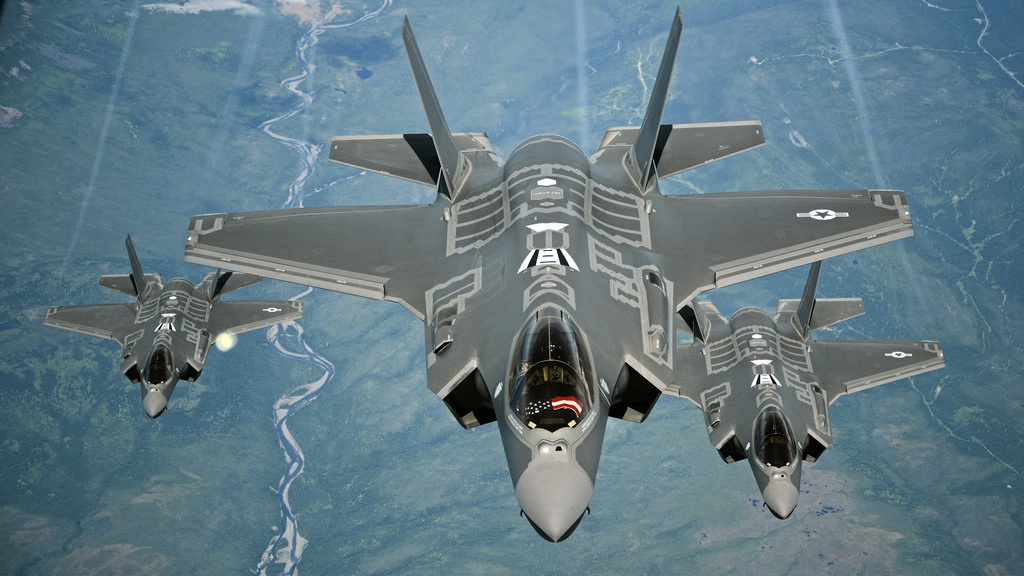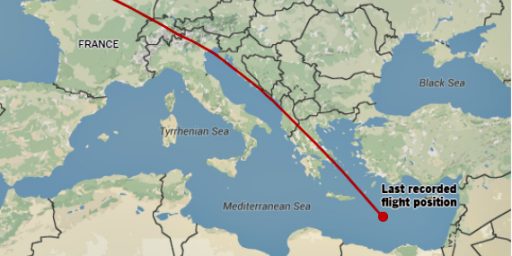German Air Force Wants F-35; German Government Doesn’t
Pork barrel politics is complicating Germany's replacement of its 1970s fighter jet.
Pork barrel politics is complicating Germany’s replacement of its 1970s fighter jet.
Within a decade, Germany must replace 85 of its Tornado multi-role combat aircraft. Designed and built in the 1970s by a consortium of British, Italian and West German aircraft companies, the Jets have reached a point of diminishing return when it comes to maintenance and modernization. In 2015, for example, it was reported by the German press that only 30 of the planes were combat-ready at any given time. Plain and simple, the Luftwaffe needs a new aircraft.
In May of last year, the German air force asked to be briefed on the American-made F-35, the stealthy, multi-mission, 5th-generation aircraft. Then, in November, Lt. General Karl Müllner, the Luftwaffe chief of staff, indicated his service’s preference for replacing the Tornado jets with the F-35 because of its low-observable signature and its ability to identify and strike distant targets. ”I think I have expressed myself clearly enough as to what the favorite of the air force is.” Given Russian advances in ground-based air defenses and combat aircraft, the general’s comments were not surprising from a military point of view.
But the general’s remarks may well have been a surprise to his government. In December, the Deputy Defense Minister Ralf Brauksiepe pushed back against the idea of replacing the Tornados with F-35s by simply noting that this was “not the position of the federal government.” Instead, the ministry stated that the Tornados would be replaced with the Eurofighter, an aircraft originally designed in the late 1980s and early 1990s to be an air-superiority fighter but which has evolved into a multi-mission platform. Like the Tornado, the Eurofighter is built by a consortium (Germany, Italy, UK and Spain) of European nations.
The rest of the report notes that this is the rub: the understandable desire to preserve the local defense industry rather than spend huge amounts of money for an American airplane. Despite early woes, the F-35 is a great plane and getting better as the kinks are worked out—which is standard operating procedure for advanced technology. And, despite the reputation for being a boondoggle in terms of cost, it’s actually cheaper than the F-22 and would be cheaper, still if it were being procured at the planned rate. The combination of austerity in most NATO capitals and the bizarre budget-without-a-budget that the US has been operating on the last decade cut acquisition considerably, boosting the per-unit price of the early inventory. More countries getting on board produces economies of scale since the R&D costs are the same whether one plane or thousands are sold.







Would the United States buy a European plane if it were better than available American planes? I expect it wouldn’t; part of national defense is having control of the production of your arms. It makes sense for countries to support the local arms industry.
As well, I find it very hard to believe that money spent on R&D for local military aircraft doesn’t have down the road benefits (sometimes not even far down the road) for local commercial aircraft.
Basically, it makes sense for Germany to buy local planes, just as it makes sense for America to buy American planes.
@george:
We’ve bought European-made military aircraft before; the Harrier jump-jet comes to mind. And the JSF was conceived as a NATO-wide project. But, yes, there’s a lot of tension in outsourcing one’s defense industry.
@James Joyner: Also the English Electric Canberra, the B-57 in US service, including Vietnam. The Harrier was later redesigned and produced as the McDonnell Douglas AV-8 while the Canberra was later produced under license in the States by Martin. IIRC we operated a few Spitfires and Mosquitoes during WWII, and I believe other British aircraft.
Something as hi tech as the F-35 may not lend itself to consortium production, but one wonders if enough European content couldn’t be arranged.
Also there is the Eurocopter HH-65 Dauphin (Dolphin) operated by the Coast Guard (107 of them).
First of all, the F-35 is three planes, not one. It’s not yet clear how many of those 3 are (or will be) “great planes”. It depends critically on what they’re expected to do — and the answer to that is different for the 3 variants.
That’s an odd comparison, given that it does not replace the F-22 and could not do the F-22’s mission. (On top of which, the F-22 was also a cost boondoggle, and would have been cheaper if produced at higher rates for more years…)
It is not being procured at the planned rate because it is not READY to be procured at the planned rate. The software is not finished and they are still tweaking the design(s). Every plane made now will have to be remanufactured later, at additional expense. The only reason to be making any at all currently is to support training and CONOPS development.
The F-35 is not the disaster it appeared to be for so long, but that doesn’t mean it’s been a successful program. We would have been much better off with 3 separate development efforts, rather than pretending that we could achieve high commonality (and thus low cost) across the three very different mission sets involved.
@James Joyner:
Fair point. Out of curiosity, were those major elements of the air force, on the level of the German’s buying the F-35?
The whole downstream issue to commercial sales came up in Canada after Boeing’s complaining about Bombardier getting a gov’t subsidy for commercial craft while Boeing got huge military contracts from the US gov’t. Not many analysts seem to believe the wall between military and commercial is anything close to watertight – again an example of gov’ts trying to keep alive certain homegrown technologies (both Canada and the US in that case).
James Joyner,
The F-35 JSF aircraft designs will not meet specification nor the operational requirements laid down in the JSF JORD (Joint Operational Requirements Document) by significant degrees, noting that these operational requirements and resulting specifications, themselves, were predicated on the capabilities of reference threats from an era past and subsequently subjected to the illogical and deeply flawed process known as CAIV (Cost As and Independent Variable).
The designs of all three F-35 variants are presenting with critical single points of failure while even the most basic elements of aircraft design (e.g. weight, volume, aerodynamics, structures, thermal management, electrical power, etc.) will almost certainly end up in what Engineers call “Coffin Corner”.
In essence, the unethical Thana Marketing strategy used to sell the F-35, along with the acquisition malpractice of concurrency in not only development, production and testing but the actual designs of the F-35 variants, themselves, have resulted in the F-35 marketeers writing cheques that the aircraft designs and F-35 Program cannot honour.
Lockheed Martin is a tremendously effective marketing organisation and they acquire all kinds of political influence both through the route of politics of the country, contributing to parties, through retired officers, and through their own marketing organisation which is extremely effective. It is an amazingly good marketing organisation backed by a company that doesn’t build very good aeroplanes.
Its thana marketing strategy which is basically designed to enable Lockheed Martin to rape any nation’s pillaging taxpayers money in the western world for the next 40 to 50 years.
Why do you think the F-35 program will ever succeed? The problem with the F-35, is the fact that is not a good enough reason to keep it going. Saying the F-35 is too big to cancel is a complete excuse. Size is not relevant to failure. The F-35 has already failed, so it needs to be cancelled. Because if you keep on going ahead with the F-35 you will weaken your defence and the allies defence as well.
The F-35 will be the world’s most appalling air power asset, effectively vulnerable to enemy air defences, beatable in air combat and bringing in a host of unreliable sensors etc.
The F-35 is not the all-singing, all dancing platform that was once envisaged or expecting in some quarters, though at the same time it will be much more incapable and inflexible aircraft than any tactical aircraft that has gone before.
F-35 advocates/fanbase people are certainly missing the big picture. They’ve have wrongly and continue to be proven wrong to point out that Within Visual Range (WVR) dogfight is the sine qua non of air combat. I emphasize that the F-35 pilot unaffords its pilot with no opportunity to see and kill the enemy at Beyond Visual Range (BVR). Because the nose geometry of the F-35 limits the aperture of the radar. This makes the F-35 dependent on supporting AEW&C aircraft which are themselves vulnerable to long range anti-radiation missiles and jamming. Opposing Sukhoi Su-30/35, let alone the Su-57 PAK-FA, J-20 and J-31 5th Generation Fighter aircraft have a massive radar aperture enabling them to detect and attack at an F-35 long before the F-35 can detect the Su-30/35, Su-57, J-20 & J-31. The F-35 will be hopelessly outclassed in Within Visual Range (WVR).
The F-35 will be several times more vulnerable than any legacy fighters. It will be several times more ineffective at air-to-air and air-to-ground combat. It will be far worse at electronic warfare. It will be far worse at reconnaissance.
Well, the observation the F-35A doesn’t come within a bull’s roar of being the best aircraft for Germany is right on the money.
The trajectory on which this folly has been allowed to place Ministries and Departments of Defence around the western world begs the question:
“What is America and its allies are going to do in the post-2015 ‘stealth-on-stealth’/’counter-stealth world’ when all the leading reference threats (both airborne and surface based), being produced by some of the world’s best new-age capitalists, all have the common design aim of overmatching and defeating the F-22A Raptor and B-2A Spirit stealth aircraft; especially when there are so few of these particular assets to be a persuasive deterrent let alone an effective defence?”
It is an unmitigated disaster in the history of air warfare. Lockheed Martin has a loser on its hands — a really big one.
Some people are telling some crazy lies about the F-35, in order to bad mouth the plane and based on some kind of agenda. The reality is the F-35 is a damn good plane. At Red Flag it had a 20 to 1 kill ratio. At BVR and WVR, it will kick ass. As for the WVR argument, clearly clueless people don’t know about DAS and it’s other advanced systems. Listen for yourselves about it’s fighting ability.
https://youtu.be/zgLjNsB_hyM
Trudat,
Total hogwash! F-35 advocates/fanbase people are telling some crazy lies saying it’s a damn good plane, in order to praise the pregnant guppy and based on some kind of agenda.
At BVR and WVR, it will certainly be several times more vulnerable. As for the WVR argument, clearly clueless people, like you pal, listen for yourselves about it’s poor fighting ability against the F-16D Block 40 in a simulated dogfight back in January 2015.
It’s right here – http://www.pogo.org/straus/issues/weapons/2015/leaked-f-35-report-confirms-deficiencies.html
Trudat,
The F-35 is ineffective as a air superiority fighter.
The F-35 was intended to be a multi-role aircraft from its inception. This latest report provides a clear picture of how it stacks up so far in its various roles, including in comparison to each aircraft it’s supposed to replace. The news is not encouraging.
The F-35’s shortcomings as an air-to-air fighter have already been well documented. It famously lost in mock aerial combat within visual range (WVR), where its radar stealth is of no advantage, to an F-16 in January 2015, one of the planes the F-35 is supposed to replace as an aerial fighter.
The F-35 lost repeatedly in air-to-air manoeuvring despite the fact that the test was rigged in its favour because the two-seat F-16D was further loaded down with heavy, drag-inducing external fuel tanks to hinder its manoeuvrability. F-35 do-gooder boosters argue that the plane’s low radar signature will keep it out of WVR situations, but the history of air combat has shown time and time again is that WVR engagements cannot be avoided altogether. Missile failures, the effects of radar jamming and other hard-to-predict factors tend to force WVR engagements time and again.
This latest report confirms the F-35 is not as manoeuvrable as legacy fighters. All three variants “display objectionable or unacceptable flying qualities at transonic speeds, where aerodynamic forces on the aircraft are rapidly changing.” One such problem is known as wing drop, where the jet’s wingtip suddenly dips during a tight turn, something that can cause the aircraft to spin and potentially crash.
Transonic speeds, just below the sound barrier, are the most critical spot of the flight envelope for a fighter plane. These are the speeds where, historically, the majority of aerial combat takes place. And it is at these speeds where the F-35 needs to be the most nimble to be an effective fighter.
The program has attempted to fix the manoeuvrability performance problems by making changes to the F-35’s flight software rather than by redesigning the actual flight surfaces that are the cause of the problems. The software, called control laws, translates the pilot’s stick commands into behaviour by the aircraft. One would expect that certain force by the pilot on the stick would result in an equivalent response by the plane. Because of the software changes, that’s sometimes not the case. For example, if a pilot makes a sharp stick move to turn the plane, the control law software now results in a gentler turn to prevent problems such as (and including) dig-in. F-35 apologists try to dismiss such issues by claiming that the F-35 was never intended for close-in aerial dogfighting, a claim belied by the Air Force’s insistence that the jet be equipped with a short range air-to-air gun.
As an air-to-air fighter, the F-35’s combat capability is extremely limited because at the moment the software version only enables it to employ two missiles, and they have to be the radar-guided advanced medium-range air-to-air missiles (AMRAAMs); in the future it will carry no more than four if it wants to retain its stealth characteristic. The F-35’s capability as an air-to-air fighter is currently further limited because the AMRAAM is not optimised for close, visual-range combat. (Eventually, upgraded software versions will allow the plane to carry missiles other than AMRAAMs, but not any time soon.) This means that any fight the F-35 gets into had better be short, because it will very quickly run out of ammunition.
Its gun would be available in close-in fighting as well, but it’s not currently working because the software needed to effectively use it in combat hasn’t been completed. The cannon in the F-35A sits behind a small door on the side of the aircraft that opens quickly an instant before the cannon is fired—a characteristic intended to keep the aircraft stealthy. Test flights have shown that this door catches the air flowing across the surface of the aircraft, pulling the F-35’s nose off the aimpoint resulting in errors “that exceed accuracy specifications.” Engineers are working on yet more changes to the F-35’s control laws to correct for the door-induced error. Making these changes and performing the subsequent “regression” re-testing to confirm the effectiveness of the changes have delayed the actual gun accuracy tests. Until these tests occur, no one can know whether the F-35A’s cannon can actually hit a target.
The F-35B and F-35C will both use an externally mounted gun pod rather than an internal version like the Air Force A-model. Because of differences in the shape of the fuselage of the two models, the Marine Corps and Navy will use different model gun pods. Both have been test-fired on the ground, but the flight tests to see what effect the pods have on the jet’s aerodynamics are only just now beginning. DOT&E has warned that, as happened with the gun door on the F-35A, unexpected flight control problems are likely to be discovered. The fixes to these will have to be devised and then tested as well. Only then will the program be able to begin the fuller in-flight accuracy testing, which is necessary to determine whether the gun pod is accurate.
Developmental testing delays, and the process of fixing the problems that testing will likely uncover, are severe enough that the program may not have an effective gun for Initial Operational Test & Evaluation. This could not only further delay scheduled testing but also, more importantly, prevent the aircraft from reaching the warfighter any time soon.
Trudat,
The problems of the F-35 keep getting worse and worse. The more they test it, the more they find to fix. They put Band-Aids on top of Band-Aids, but then they test the Band-Aids, and the Band-Aids don’t work.
Trudat,
Some of the test pilots agree the F-35 is a terrible dogfighter. It’s now being billed as a ‘fire and run’ war plane. The problem with that is, in the face of superior Russian ECM, the F-35 cannot expect its missiles to track. So the F-35 will just have to fire all missiles, turn and run and hope for the best, which it still can’t turn & run. The F-35 is at a clear disadvantage to all 4th Gen and 5th Gen aircraft. A trillion dollars in development and the F-35 is vulnerable to everything else flying today.
The F-35 will eventually kill itself with its own failings.